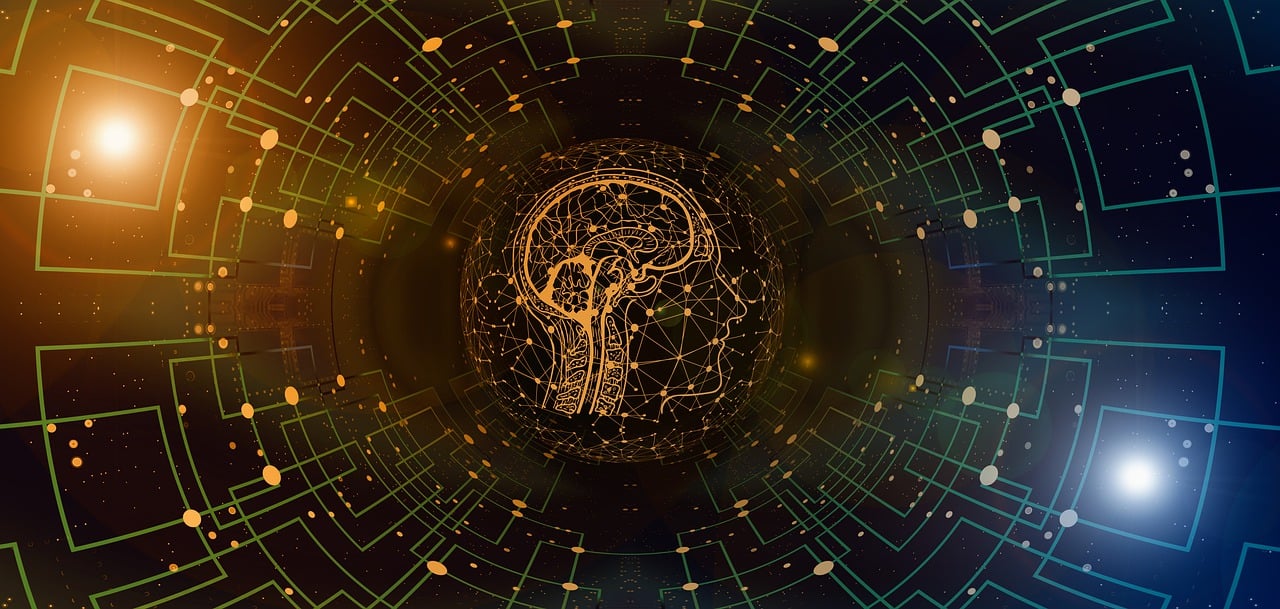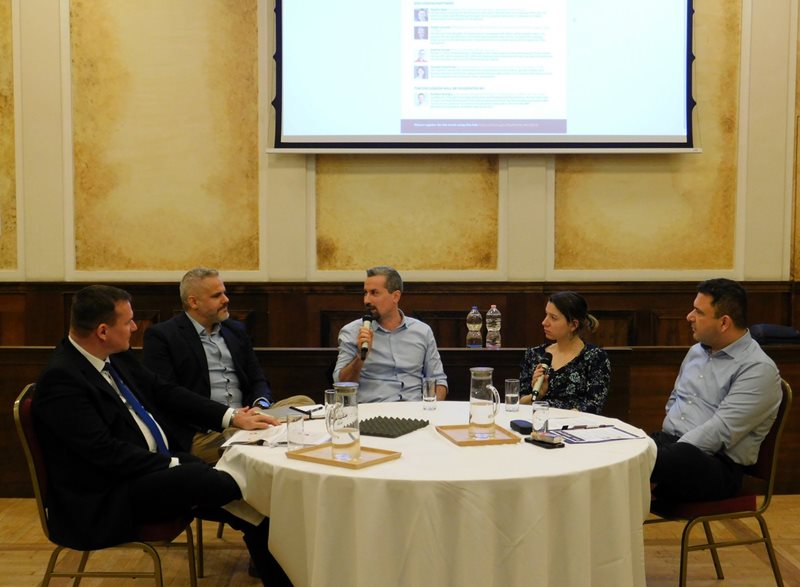’The real danger is not that machines will think like us, but that we will think like machines’

The panel discussion titled ’What can artificial intelligence add to human development?’ took place in the framework of the research week, with the participation of Orsolya Vásárhelyi, assistant professor and researcher of human-machine interactions at the Corvinus University of Budapest, Sándor Baja, managing director of the Randstad recruitment company in Hungary, the Czech Republic and Romania, Gergő Lencsés, managing partner of the Zero Emission Leadership HR technology company and András Vicsek, innovation director of Maven7. The discussion was moderated by innovation management expert Achilles Georgiu and covered, among others, topics such as the potential of artificial intelligence, emerging threats and impacts on society.
“What is artificial intelligence?”
Artificial intelligence is a catch-all term for a lot of different software types, although most experts believe that it is almost impossible to generalise in the case of AI. Artificial intelligence is under continuous development, while it is available to everyone, so it is important to understand what exactly it means. According to the definition by the European Parliament, modern AI is a system that has human-like capabilities, therefore it is able to perceive its environment and take action and adapt itself to maximise the chances of achieving the goals set.
Any computer system or physical machine that attempts to imitate human thinking is considered artificial intelligence. Language and language models are at the heart of the software, and although it initially became widely known in society as a text generator, that is no longer the primary use of AI. AI processes huge amounts of data in seconds, significantly exceeding the capacity of the human brain. ’It is a fantastic forecasting machine, sometimes it is scary how good it is,’ agreed the panellists. One of the biggest benefits of AI is that it is available free-of-charge and can replace expensive software, saving significant costs for businesses.
How do we use AI?
‘The most important thing is to see it as an asset,’ Orsolya Vásárhelyi stressed. In order to achieve the expected result, it is essential to use AI consciously, and this can be achieved by planning in advance what we want to achieve with it. At the same time, it is essential to know what we are using, without simplifying or perhaps over-mystifying the capabilities of AI.
‘You must never trust it,’ the experts stressed. Artificial intelligence is capable of generating false information, so it is important to always be critical and check the authenticity of the results, as the system uses all the information that is posted on the internet without filtering.
One of its major benefits is that it can save time for us and increase our productivity. Artificial intelligence can never be a substitute for creativity – as it uses existing data and it can only generate texts, images and sound from that -, so creativity remains a human task.
What are the possible communication effects?
The human factor is missing from machine-generated texts used for communication purposes, so the lack of new ideas and human emotions leads to the loss of the relevance of the text. ‘We can observe a tendency to humanise robots while robotising humans,’ Sándor Baja pointed out. He claims that we can observe different trends that indicate changes in habits, but human relationships are still the dominant factors, regardless of the advances in technology.
Software is already used in a number of areas to perform various background tasks, it is enough to think of social media algorithms or chatbots. In many cases, users are unaware that the service they are using is based on artificial intelligence, and this unknown and so far alien phenomenon can often fill us with fear, reduce trust or trigger a process of fragmentation, while spontaneous and personal interactions may completely disappear from consumers’ lives.
AI can be used in decision-making processes, too, as it can quickly identify the preferred option thanks to its ability to perform quick statistical operations, and this can have an impact on the work of decision-makers and management. However, the results obtained do not always follow the considerations used in human decision-making, and unexpected situations cannot be programmed into the analysis yet, so we should always examine the results carefully.
What are the dangers?
‘When we solve a big problem, we generate lots of smaller ones at the same time,’ said the experts when they started to analyse the topic in more detail. One of the biggest hazards in using artificial intelligence is the occurrence of inequalities and biases in black box operations, as developers are not yet able to influence these. As AI uses existing data and statistics, it can easily amplify existing inequalities.
‘A research showed that when an AI software was doing HR work for an IT company, the software determined the gender of the candidate on the basis of the data in the CV, and hired men only, because based on the existing data, 80% of the people working in the industry are men,’ said Orsolya Vásárhelyi as an example. She agreed, however, that a suitable candidate has more chance to get a particular job if the AI looks through the CVs, as it processes the information much more thoroughly than a human. In this respect, the presenters revealed that an average HR person usually looks at a CV for two seconds.
The fact that our electronic devices know more about us than our family and friends can be a basis for abuse, but Sándor Baja stressed the following: ‘It is not the software we fear, but the person who controls it.’ It is therefore important to highlight transparency in relation to the programme. The two basic types of fear are external and internal fear. The first group includes specific external alarming impulses and sources of danger such as snakes or height. On the other hand, when we start to feel anxious in a safe situation, it is an internal fear. This category includes stage fright and fear of artificial intelligence, too. We are not afraid of the technique itself or the person behind it, but we attach negative emotions to it because we are inexperienced and helpless in the given topic.
How can development be controlled?
‘Built-in inequalities are scary only as long as we don’t know about them,’ said Gergő Lencsés. AI would be a good opportunity to reduce social prejudices, as algorithms can take into account data that humans wouldn’t even think of, and can be programmed precisely to serve our purposes. However, it is necessary to know the exact source of the data and the rules and barriers built into the programme. Therefore the legal framework required to avoid similar problems and to define the precise scope of liability is an important question.
Another necessary element is to make information available and to promote relevant knowledge through various educational materials, so that extreme views could be transformed into more comprehensive opinions.

What can we expect in the future?
When Achilles Georgiu asked his conversation partners what they expected from the future, they all agreed that the future was unthinkable without artificial intelligence. The various AI-based software programmes offer essential means to maintain robust electronic systems, various complex technological devices and services. ‘I use it every day, but sometimes I’m afraid of it or hate it,’ said Orsolya Vásárhelyi, who stressed that you should use this technology only if you know what it can do.
Translation is a potential area of application, as there are already a number of AI-based programmes available, and some technologies are capable of performing simultaneous translation tasks, too, owing to speech recognition. This is why further progress is predicted in overcoming language barriers in the future.
Health and security policy are among the fastest growing areas where AI-based algorithms also entail huge potentials. Its use in education allows us to focus on the social possibilities offered by schools and ensures a more personalised pace and tasks to students, while developing soft skills and practical skills. There are virtually no limits to the use of artificial intelligence, and, in addition to the above areas, it can be extended to cover environment protection, the fight against terrorism, or even the promotion of integration into society.
However, this vision still refers to the distant future, as currently, in most countries, only a fraction of the population has access to AI or opportunity to use it consciously, and not many companies are planning to introduce it at at the moment. ‘We overrate everything new in the short term and underrate it in the long term,’ said András Vicsek, who went on to say that it was completely understandable that many people saw artificial intelligence as the end of humanity. There have been examples of this attitude before, just think of the appearance of the internet. He also stressed that technical innovation must go hand in hand with social renewal.
Software-based systems cannot be programmed for unexpected situations, so, in a lot of cases, they are unable to fully replace human skills. One of the examples is the use of AI in healthcare: when identifying diseases, a doctor has to weigh the accuracy of the diagnosis based on the symptoms.
In the long term, AI can take over a lot of tasks from humans, freeing up considerable time, but, at the same time, a lot of people fear that they could lose their jobs because of AI. Gergő Lencsés responded: ‘McDonald’s still employs people. And if AI takes over all the tasks, what will be left? The fact that we are human.’
Photoép: Tóth Valter
Written by: Katalin Bogos